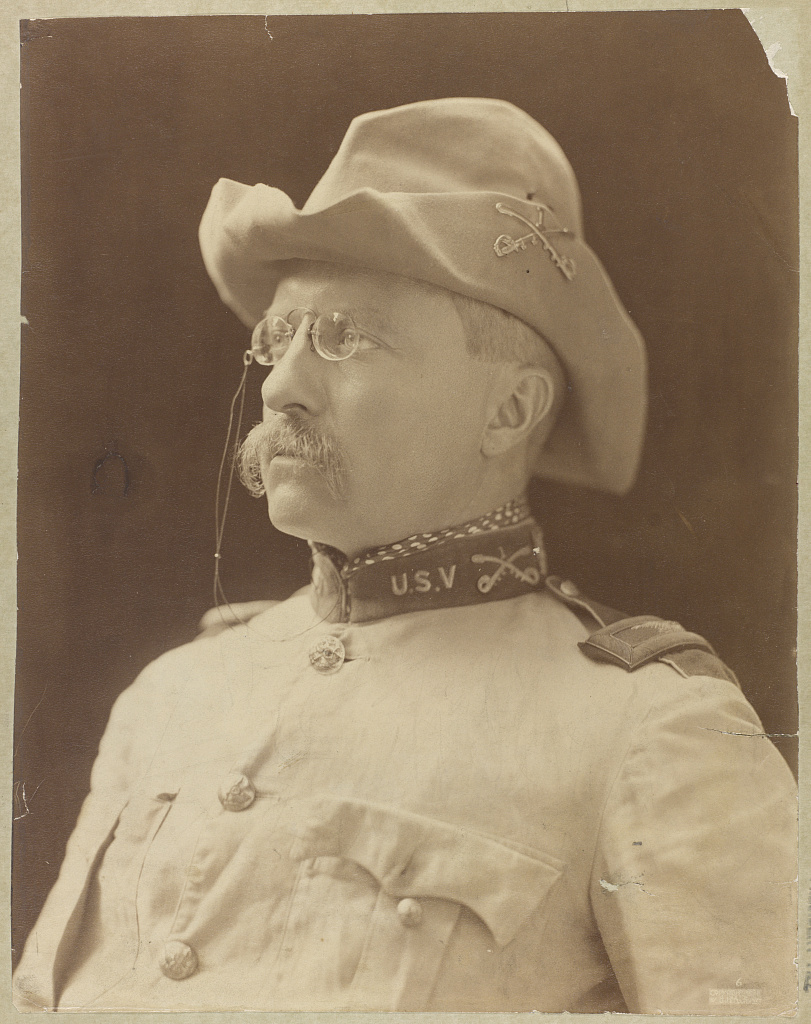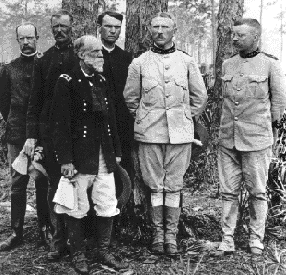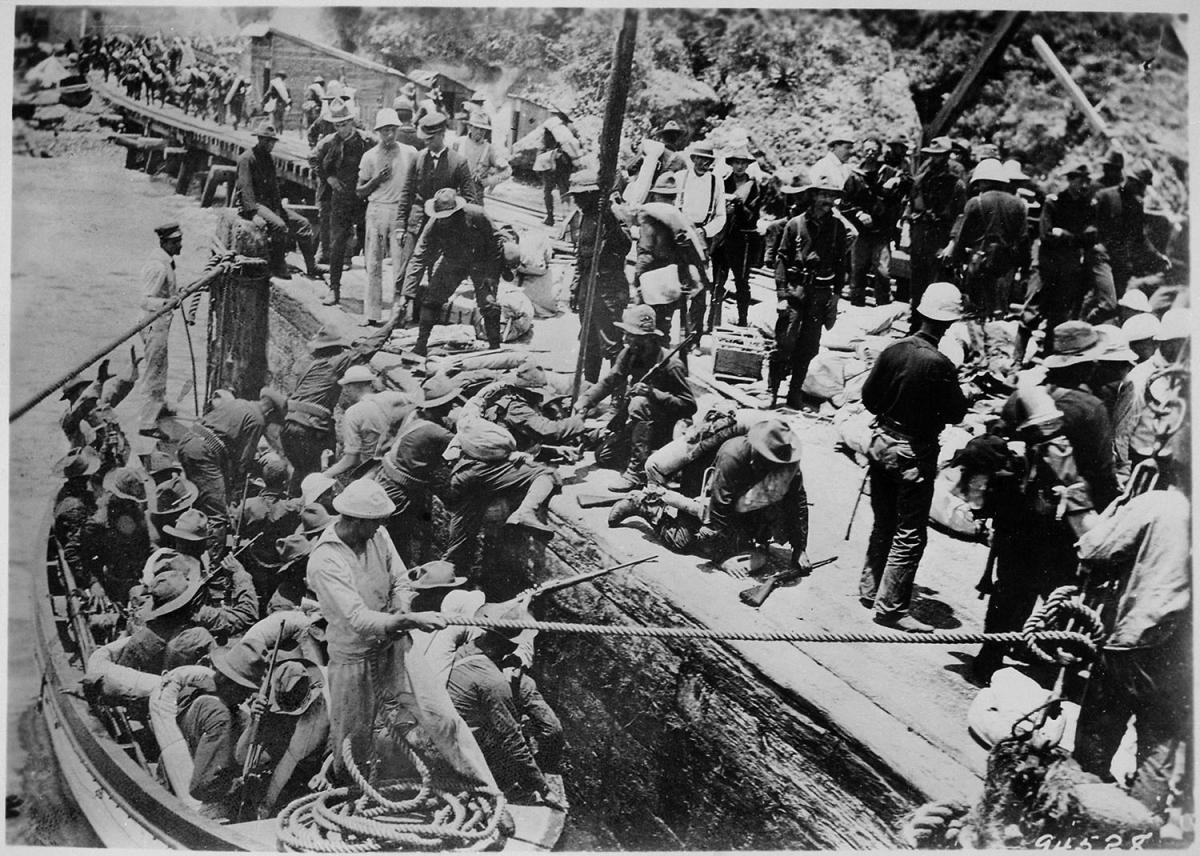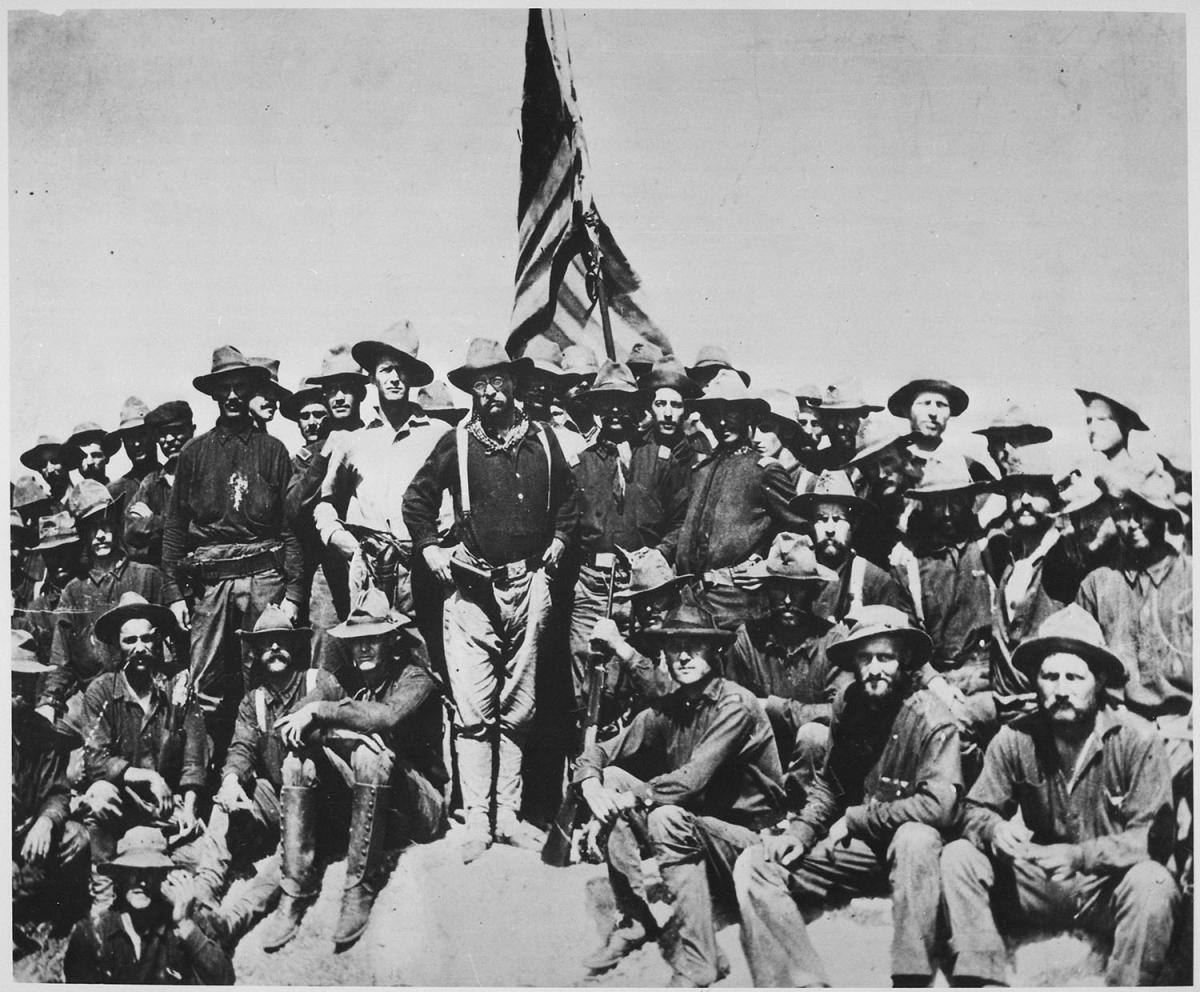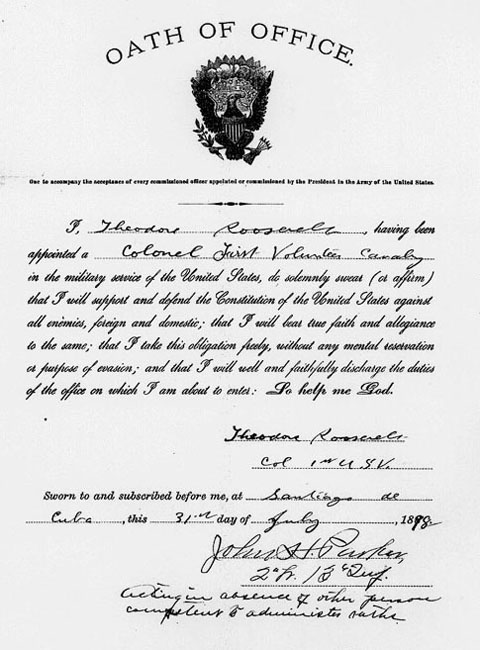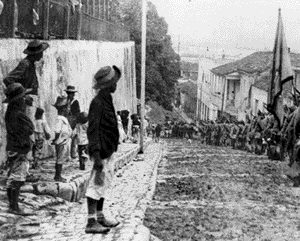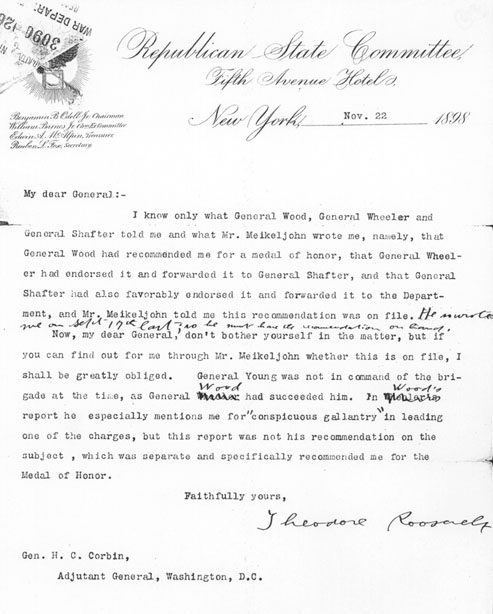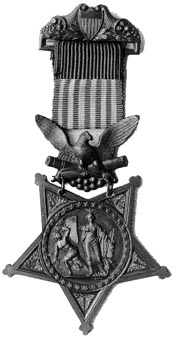
“I Am Entitled to the Medal of Honor and I Want It”
Theodore Roosevelt and His Quest for Glory
Spring 1998, Vol. 30, No. 1
By Mitchell Yockelson
Among Theodore Roosevelt's many accomplishments were two terms as President of the United States, the publishing of more than forty works of nonfiction, the exploration of the South American wilderness, and having his likeness sculpted on Mount Rushmore. However, even with all of these and many other achievements, Theodore "Teddy" Roosevelt often stated that participating in the Battle of San Juan Hill, Cuba, during the Spanish-American War was one of his proudest moments. Roosevelt's service with the First U.S. Volunteer Cavalry Regiment, also known as the "Rough Riders," lasted only four months, but he proclaimed "there are no four months of my life to which I look back with more pride and satisfaction."(1) To most people, the charge up San Juan Hill is one of the two most memorable events connected with the "Splendid Little War."(2) The other is the sinking of the USS Maine, which helped set the stage for war.
The American victory over Spain placed the nation among the world's great powers. For Roosevelt, the Spanish-American War fulfilled a lifelong dream. While friends in the newspaper business ensured that his exploits in Cuba were not overlooked by the public, the future President yearned for even greater acclaim. He coveted the country's highest military decoration, the Medal of Honor. Despite an intense lobbying effort by some of his superior officers and a close friend, Senator Henry Cabot Lodge, Roosevelt's request for the medal was denied by the War Department. Questions remain as to whether Roosevelt was refused the Medal of Honor because he was undeserving or if friction between himself and the War Department was the actual reason for denial.
Although countless pages have documented the Rough Riders in Cuba, the Medal of Honor issue has been largely ignored in print. Even two of Roosevelt's own publications, The Rough Riders and An Autobiography, fail to mention in the narrative his desire for the award.(3) A multitude of War Department documents and Roosevelt's own published letters clearly state his argument that "I am entitled to the Medal of Honor and I want it."(4) With the centennial of the Spanish-American War approaching, perhaps this is an appropriate time to reevaluate Roosevelt's role in the conflict and determine if his contribution was as worthy as he claimed.
After the Maine exploded in Havana Harbor, Cuba, on February 15, 1898, popular opinion in the United States cried for retaliation against Spain. The fever was fueled by yellow journalists such as Joseph Pulitzer of the New York World and William Randolph Hearst of the New York Journal. One of the most anxious Americans was Theodore Roosevelt. When he had taken office as assistant secretary of the navy in April 1897, he used his position to expound upon America's future role as a world power. He felt this goal could not be achieved without war. During a June 2, 1897, speech at the Naval War College in Newport, Rhode Island, the assistant secretary noted that "diplomacy is utterly useless where there is no force behind it; the diplomat is the servant, no the master, of the soldier. . . . No triumph of peace is quite so great as the supreme triumphs of war."(5)
With war declared on April 21, 1898, the self-proclaimed jingo saw his wishes come true and was anxious to take part in the upcoming fray. Several years after the war, he boasted that "I had always felt that if there were a serious war I wished to be in a position to explain to my children why I did take part in it, and not why I did not take part in it."(6) The latter portion of this statement was probably a reference to his father's decision not to serve in the military during the Civil War, which haunted Roosevelt throughout his life. According to one of his biographers, "family, friends, and superiors all implored Roosevelt to remain in the post in which he had done so much to prepare the navy for war."(7) Roosevelt ignored these pleas and instead lobbied Secretary of War Russell A. Alger for an army commission. Opportunity came for Roosevelt when the War Department mobilized the army for war.
A severe shortage of men prevented the army from immediately setting forth on an expedition to Cuba. To remedy the situation, President William McKinley proposed to Congress a first call for 125,000 state volunteers. The proposal became law on April 22. Four days later, additional legislation was passed to increase the regular army to more than twice its strength. On May 25, McKinley issued a second call for 75,000 volunteers to bring the army up to adequate strength for whatever expeditions might be required.
Most of the volunteers under the first call came from existing state militia or national guard outfits since they numbered about 125,000 men. The order for troops also permitted the federal government to raise three volunteer cavalry regiments to serve independently from the state units.(8) Secretary of War Alger knew the perfect candidate to command the first regiment: Theodore Roosevelt. Upon learning from Alger that the First United States Volunteer Cavalry Regiment was his to command, Roosevelt was ecstatic. He declined the offer, however, since his only military service had been three years in the New York National Guard, and he felt this was not enough experience to lead an entire regiment during wartime. As a compromise, Roosevelt suggested that he serve as lieutenant colonel if his good friend Leonard Wood was named as the commander. Alger agreed, and the Rough Riders were born.(9)
Wood was an ideal choice to command the newly formed regiment. He had many of the same political connections as Roosevelt, whom he had met in mid-1897 while serving as the White House physician, and they developed a deep friendship. Besides a career as a medical officer, Wood had served as both an army assistant surgeon and line officer during the expedition against Geronimo in 1886. He distinguished himself in the campaign and received the Medal of Honor in March 1898 for his role in Geronimo's surrender. Wood was the only officer serving in the long campaign to receive the award, and rumors circulated that his political ties were the reason he had been singled out.(10)
Secretary of War Alger authorized Wood to raise and organize "a regiment of Volunteers possessing special qualifications as horsemen and marksmen." Furthermore, War Department Special Order #98, April 27, 1898, directed Wood to report to Muskogee, Indian Territory; Guthrie, Oklahoma; Sante Fe, New Mexico; Prescott, Arizona Territory; Carson City, Nevada; and Salt Lake City, Utah for recruiting.(11) But once the word spread that the Rough Riders were recruiting men, applications came from all over the country. Originally the regiment was allotted 780 men by the War Department, but popular interest in becoming a Rough Rider quickly enlarged the number to 1,000. By July 7, 1898, the regiment exceeded the legal limit of men, with more than 1,100 names on the muster rolls.(12)
The origin of the name "Rough Riders," according to Roosevelt, was created "both by the public and by the rest of the army . . . doubtless because the bulk of the men were from the Southwestern ranch country and were skilled in the wild horsemanship of the great plains."(13) Publicly, Roosevelt invoked an image as a cowboy because of the several years he spent ranching in the Dakota Territory and the publication of his multivolume work The Winning of the West. In addition to the majority of cowboys and ranchers, recruits came from Ivy League schools such as Harvard, Yale, and Princeton. Roosevelt also recruited at the various social clubs of Boston and New York with which he was well acquainted. From this contingent Roosevelt especially sought athletes such as cross-country riders and polo players. Notable among the blue-blood eastern families recruited for the Rough Riders was Hamilton Fish, the nephew of former Secretary of State Fish. Most noteworthy of the western recruits was William "Bucky" O'Neil, who was the mayor of Prescott, Arizona, and a famous sheriff. A number of Native Americans representing tribes such as the Cherokees, Chickasaws, Choctaws, and Creeks rounded out the regiment.(14)
The Rough Riders trained in San Antonio, Texas, for about four weeks, then joined the other outfits congregating in Tampa, Florida, for transport to Cuba.(15) The expedition was organized as the U.S. Army's Fifth Corps. They were led by the rotund Maj. Gen. William R. Shafter, a Medal of Honor recipient during the Civil War and veteran of the Indian wars. The Rough Riders had the distinction of being one of only three volunteer regiments that initially went to Cuba.(16)
Leaving Tampa on June 6, the Fifth Corps anchored a week later off the coast of Santiago de Cuba and remained there until an advance force of the U.S. Army landed at the small port of Daiquiri, seventeen miles from Santiago. With the help of naval gunfire and a small force of Cuban revolutionaries under the command of Gen. Calixto Garcia, the three hundred Spanish troops in the area of Daiquiri were forced to withdraw on June 22. Because of heavy surf conditions, Shafter selected a landing point eight miles closer to Santiago at the port of Siboney. By June 26, most of the expedition was on shore, but not without casualties. Two men and a number of artillery horses and pack mules drowned in the rough sea. Roosevelt remembered that "we did the landing as we had everything else--that is, in a scramble."(17)
Upon landing in Cuba, the mission of the Fifth Corps was unclear. The War Department gave Shafter instructions to destroy the Spanish forces at Santiago, and how to go about this was left up to him. As soon as a sufficient force landed on shore at Siboney, Shafter ordered the march toward Santiago. Although the Spaniards put up no resistance to the American landings, Cubans in the area reported that a force of two thousand Spaniards were about four miles from Siboney in the village of Las Guasimas. Former Confederate officer Maj. Gen. "Fighting" Joe Wheeler, who commanded the Fifth Corps cavalry division as a volunteer, sent Brig. Gen. Samuel B.M. Young on a reconnaissance toward the village with his brigade, which included the Rough Riders and the African American Tenth U.S. Cavalry. After a two-hour fight, Young's brigade had the enemy fleeing toward Santiago.(18)
Sixteen Americans and ten Spaniards were killed in the fight. Figuring prominently in the skirmish were the Rough Riders, who suffered eight casualties. Newspapers across the United States proclaimed it a Rough Riders victory. Most responsible for the accolades was correspondent Richard Harding Davis, who tagged along with the Rough Riders and acted as Roosevelt's own press secretary. In reality, Wheeler had advanced the cavalry prematurely, and they had been ambushed. Two of the Rough Riders killed were among the regiment's more promising troopers, Capt. Allyn K. Capron and Sgt. Hamilton Fish. The most positive aspect of the skirmish was that it boosted morale among the soldiers and gave them confidence for the big fight that lay ahead.(19)
After the unexpected Las Guasimas fight, Shafter decided against any further advances until he could build up substantial supplies at Siboney and Daiquiri. On June 28 Shafter learned that a Spanish relief force was heading to reinforce troops entrenched among the heights surrounding Santiago. Two days later he ordered his forces to be ready to march toward Santiago on July 1. The ultimate goal was San Juan Hill, which was also known as either San Juan Heights or San Juan Ridge.(20)
The San Juan Heights rise above Santiago, about two miles east of the city. A small rise known as Kettle Hill was named for an abandoned mill and its iron kettles used to refine sugar. San Juan Hill rises to the southwest, about 400 yards further than Kettle Hill, and stands about 125 feet high with a brick blockhouse at the summit. Just east of Kettle and San Juan Hills flows the San Juan River. Approximately a thousand yards west of the San Juan Heights there was a strong line of Spanish fortifications that included barbed-wire entanglements, rifle pits, and trenches dug on the heights and to their rear.
Shafter's plan to assault the San Juan Heights, based upon reconnaissance by his own troops and the Cuban army, was to send the Fifth Corps through the only two practicable routes in the jungle-covered terrain. The First Infantry Division under Brig. Gen. Jacob F. Kent and Wheeler's cavalry would approach Kettle and San Juan Hills through the same road the army had followed from Siboney. The first phase of the attack was for Brig. Gen. Henry W. Lawton's Second Infantry Division to take the village of El Caney on the right flank by way of the road to Guantanamo, which he claimed was possible in two hours. Lawton was then to move on to Santiago with Kent and Wheeler approaching to his left. If the plan went as designed, the three divisions would clear the Spaniards from the San Juan Heights and bring Santiago under siege.
The Battle of Santiago began early in the morning of July 1 with Lawton attacking El Caney, but his force of sixty-six hundred men met heavy resistance from the five hundred Spaniards garrisoned at the village. Not until late afternoon did El Caney come under American control.
With Lawton bogged down in El Caney, the First Cavalry Division and First Infantry Division with about eight thousand men would have to attack the defenses of San Juan Heights without the planned infantry support. The cavalry was now under the command of Brig. Gen. Samuel S. Sumner, who temporarily replaced an ill General Wheeler. As result of Wheeler's illness, Wood was promoted to brigadier general, and Roosevelt was raised to the rank of colonel of the Rough Riders.
The infantry division under General Kent moved behind the Sumner's cavalry division along the road leading to the heights at about 11 a.m. Gradually the infantry pressed up alongside the cavalry, then both divisions took position in an area that provided little cover, with the cavalry on the right and the infantry on the left. Not yet having received orders from Shafter's headquarters, the men were exposed in the open with no clear course of action. Before the men completed their deployment, the Spanish troops on San Juan and Kettle Hills commenced rifle and artillery fire.
What triggered the Spanish fusillade was an observation balloon operated by the Signal Corps. Their mission was to obtain more intelligence about the Spanish position, but the balloon gave the Spaniards a perfect marker on which to aim their fire. How many American casualties the balloon caused is impossible to say. On the positive side, the two observers aboard the balloon gathered information on the enemy's strength at San Juan Hill and discovered an alternate trail that helped spread the deployment of the Fifth Corps infantry.(21)
Sumner and Kent realized that San Juan Hill was heavily defended and the infantry and cavalry would be decimated unless they either advanced or retreated. Kent's infantry, followed by Sumner's cavalry, deployed along a narrow path, and by 1 p.m. the Americans established a firing line facing the heights against the Spanish right flank. Lt. John H. Parker and his battery of Gatling guns caused the most destruction. At a range of six hundred to eight hundred yards, Parker demoralized the Spaniards by firing continuously for little over eight minutes.(22)
Using Parker's guns as a cover, the cavalry and infantry finally received permission to attack the Spanish forward positions along San Juan Heights. What actually happened at this point is still quite confusing. A number of different versions of the battle by its participants conflict with each other. Of particular interest to this study is Roosevelt's own account of the events. In his two reports to Leonard Wood that were published in the Report of the Secretary of War, as well as his postwar story in The Rough Riders, Roosevelt gives the impression that he alone was the first to charge the San Juan Heights to drive away the entrenched Spaniards. This image of Theodore Roosevelt was propagated with the help of Richard Harding Davis. Reporting for the New York Herald, Davis transcribed what Roosevelt told him, then added his own twist to the story. In addition to the newspaper articles, magazines and books picked up his story. Davis depicted a fearless Roosevelt, wearing a blue polka-dotted bandanna, charging up the hill mounted on his horse, Texas. Thus the legend of Theodore Roosevelt was created.(23)
The first report, written on July 4, 1898, provides Roosevelt's initial claim for credit in charging the heights. He wrote,
After crossing the river at the ford we were moved along and up its right bank under fire, and were held in reserve at a sunken road. . . . We then received your order to advance and support the regular cavalry in the attack on the entrenchments and blockhouses on the hills to the left. The regiment was deployed on both sides of the road, and moved forward until we came to the rearmost lines of the regulars. We moved forward until I ordered a charge, and the men rushed the blockhouse and rifle pits on the hill to the right of our advance. They did the work in fine shape, though suffering severely. The guidons of Troop E and G were first planted on the summit, though the first men up were some A and B troopers, who were with me.
After the passage of almost three weeks, Roosevelt's final report to Wood elaborated even further on his immortal charge.
We moved through several skirmish lines of the regiment ahead of us, as it seemed to me that our only chance was in rushing the entrenchments in front. . . . Accordingly we charged the blockhouse and entrenchments on the hill to our right against a heavy fire. It was taken in good style, the men of my regiment thus being the first to capture any fortified position and to break through the Spanish lines. The guidons of G and E troops were first at this point, but some of the men of A and B troops who were with me personally got in ahead of them. At the last wire fence up this hill I was obliged to abandon my horse and after that went on foot. . . . By the time San Juan was taken a large force had assembled on the hill we had previously captured, consisting not only of my own regiment but of the ninth and of portions of other cavalry regiments.(24)
In The Rough Riders, written almost a year after the war, Roosevelt provides further assessment of his gallantry.
The General [Sumner] at once ordered the first brigade to advance on the hills, and the second to support it. The instant I received the order I sprang on my horse and then my "crowded hour" began. . . . I started in the rear of the regiment, the position in which the colonel should theoretically stay. . . . I had intended to go into action on foot . . . but the heat was so oppressive that I found I should be quite unable to run up and down the line . . . moreover, when on horseback, I could see the men better and they could see me better.I soon found that I could get that line, behind which I personally was, faster forward than the one immediately in front of it. . . . This happened with every line in succession, until I found myself at the head of the regiment. . . . The Ninth Regiment was immediately in front of me, and the First on my left, and these went up Kettle Hill with my regiment. The Third, Sixth, and Tenth went partly up Kettle Hill (following the Rough Riders and the Ninth and the First). . . . By the time I came to the head of the regiment we ran into the left wing of the ninth regulars . . . , who were lying down. I spoke to the captain in command. . . . I asked where the Colonel was, and as he was not in sight, said, "Then I am the ranking officer here and I give the order to charge. . . ." Naturally the Captain hesitated to obey this order. . . So I said, "Then let my men through sir," and rode on through the lines, followed by the grinning Rough Riders. . . .
Wheeling around, I then again galloped toward the hill, passing the shouting, cheering, firing men. . . . Some forty yards from the top I ran into a wire fence and jumped off Little Texas. . . . Almost immediately afterward the hill was covered by the troops, both Rough Riders and the colored troops of the Ninth, and some of the men of the First. There was the usual confusion, and afterward there was much discussion as to exactly who had been on the hill first. The first guidons planted there were those of the three New Mexican troops, G, E, and F, of my regiment . . . , but on the extreme right of the hill, at the opposite end from where we struck it, Captains Taylor and McBain, and their men of the Ninth were first up. Each of the five captains was firm in the belief that his troop was first up.(25)
While Roosevelt's accounts and Davis's articles make exciting reading, they do not tell the complete story. Based on official reports that Roosevelt either did not consult or refused to believe, historians writing about the battle for Santiago since July 1, 1898, have exposed a number of inaccuracies in Roosevelt's versions. Ultimately the revised histories place credit for the charge on the San Juan Heights with the regular army, whom Roosevelt ignored in his accounts. Another obvious mistake is Roosevelt's insistence in his official reports that he charged San Juan Hill, when in reality his immediate assault was on Kettle Hill. According to historians Peggy and Harold Samuels, Roosevelt had convinced himself that he had charged San Juan Hill as had Hawkins. "Although San Juan Hill and Kettle Hill were separated by geography and by difference in the quality of defenses, Roosevelt lumped together the hill, the knoll, the valley before them, and the heights as 'the battlefield at San Juan Hill.' He glossed over the clear physical difference between San Juan Hill in particular and the entire San Juan battlefield."(26)
What the evidence supports is that the cavalry division advanced to the northwest across the San Juan River and up Kettle Hill. By the time the assault reached the top of Kettle Hill the ground was practically deserted by the Spanish soldiers. Due to the confusion of the heavy fire, cavalry units were intermingled with white soldiers of the Rough Riders firing beside the colored soldiers of the Ninth and Tenth Cavalry Regiments.(27) Who reached Kettle Hill first is where the confusion lies. First Lt. Edward D. Anderson made the claim for Troop C of the Tenth Cavalry. His report states that "while advancing near the road, Colonel Wood, the brigade commander, came by and told me to move my troop to the right and toward the blockhouse. I had 1 man killed and 7 wounded in reaching the top of the hill. . . . Shortly, Colonel Roosevelt and part of his regiment joined our right and I reported to him with my troop. His command took the position behind the crest in which we now occupy."(28)
The troops on Kettle Hill under the orders of Sumner and the inspiration of Theodore Roosevelt started down the west slope of the hill and up the northern extension of San Juan Hill. The cavalry encountered trenches filled with dead Spaniards or those who wished to surrender. Some of the bolder enemy were shot in full flight by the Rough Riders and other regiments now firmly in place on San Juan Hill. The assaults against Kettle and San Juan Hills were against Spanish troops that had already begun pulling back. Around noon their two field artillery pieces had been depleted of ammunition, and their infantry had been decimated by the Gatling gun, artillery, and rifle fire. Those who remained in the trenches when the U.S. cavalry appeared were either dead or wounded. The Rough Riders did charge San Juan Hill, but only after the assault on the more strategically important Kettle Hill.
The July 1 assault on the San Juan Heights drove the Spaniards from the high ground surrounding the city of Santiago. This was accomplished at a severe cost, though, as the Fifth Corps sustained more than 1,300 casualties. The Rough Riders, who were about 490 strong when the battle started, suffered 15 men killed and 73 wounded. One of those killed was Bucky O'Neil, who was shot through the back of the head while parading in front of Troop A. Morale among the officers and men was at the lowest point of the campaign because of the high casualty rate and confusion of the day's battle.
To make matters worse, logistical problems in getting supplies and food to the men on San Juan Hill, as well as abysmal medical services, prompted Shafter to consider withdrawing on July 2 to reorganize. But the Fifth Corps remained and debated with the navy for the next several days over the course to follow for an attack on Santiago. Shafter wanted the navy to force its way through Santiago Harbor and bombard the city, while Adm. William T. Sampson wanted the army first to seize the forts at the entrance of the harbor. In the meantime, negotiations commenced between Shafter and the new commander of the Spanish forces at Santiago, Gen. Jose Toral. Shafter threatened Toral with a combined sea and land attack if the Spanish did not surrender. The final blow for the Spanish force was the fiery destruction of their squadron as it tried to flee Santiago Harbor on July 3. This, coupled with an increase in sickness and lack of food for Toral's men, induced the Spanish commander to surrender, and formal ceremonies took place on July 17.(29)
The Spaniards were not the only ones suffering from disease. By the end of July, almost 20 percent of Shafter's men were hospitalized because of yellow fever, dysentery, and a large number of malaria cases. At first the War Department felt the Fifth Corps should remain in Cuba and wait out the epidemics, but Shafter warned that the disease would worsen unless the sick men were returned to the United States. Shafter solicited the views of his division and brigade commanders, and they concurred that the weakened soldiers must leave Cuba immediately or risk yellow fever deaths rising by the hundreds. All three of Shafter's division commanders and several of the brigade officers, including Roosevelt, drafted and signed a letter stating their views on the withdrawal from Cuba. The letter was included with Shafter's dispatch and sent to the War Department on August 3. Roosevelt also took matters into his own hands and sent an urgent plea to his friend, Senator Henry Cabot Lodge. A copy of Shafter's dispatch was leaked to an Associated Press correspondent at the Fifth Corps headquarters, and the generals' letter was printed in newspapers across the United States. Although the exact source of who leaked the dispatch was never revealed, Roosevelt has often been considered the prime suspect. Because the dispatch went through so many hands, it was called the "Round Robin" letter.
The letter caused great embarrassment to the McKinley administration, which appeared cold and callous to the American public for leaving the sick troops in Cuba. McKinley was also fearful that news of a decimated army would give the Spanish more bargaining power when negotiating the armistice. The scandal became known as the "Round Robin Affair," and as a result, McKinley allowed Shafter to start sending his men north as soon as possible. The first shipload of troops left Santiago on August 7, and by August 25 the entire corps had left Cuba. The Rough Riders were among those transported on one of the first ships to leave Cuba and arrived at Montauk Point, Long Island, on August 15 to a cheering crowd.(30)
Before Roosevelt and his Rough Riders left Cuba for the United States, he commenced fighting another, personal, battle. General Wheeler promised to recommend him to the War Department for a Medal of Honor, and his good friend Leonard Wood got the ball rolling by submitting the first endorsement on July 6. In a letter to the War Department Adjutant General's office in Washington, Wood plainly stated that "I have the honor to recommend Lieut. Col. Theodore Roosevelt . . . for a Medal of Honor for distinguished gallantry in leading a charge on one of the entrenched hills to the east of the Spanish position in the suburbs of Santiago de Cuba, July First, 1898."(31)
Although a nice gesture, Wood's recommendation had very little merit. He had not been present during the actual charge, and Wood's enemies asserted that he had got lost in the woods trying to maneuver his brigade, reaching San Juan Hill only after the fighting had ended. He was therefore not a reliable witness, and the War Department would later reveal this fact. Following Wood's recommendation were similar endorsements from Generals Wheeler and Shafter. Like Wood, they also had not witnessed Roosevelt's alleged heroic charge.
Roosevelt also pushed the Medal of Honor issue to his long-time companion, Massachusetts Senator Henry Cabot Lodge. Roosevelt boasted to him "that General Wheeler intends to recommend me for the Medal of Honor; naturally I should like to have it." In a another letter to Lodge complaining about the deplorable conditions in Cuba and the deaths that might result from the malaria, Roosevelt reflected upon his own possible death. He told Lodge that "if I do go, I do wish you would get that medal for me anyhow, as I should awfully like the children to have it, and I think I earned it."(32)
Impatient to hear news about the Medal of Honor, Roosevelt wrote to the War Department in September 1898. Assistant Secretary of War George D. Meikeljohn responded that they had Wood, Wheeler, and Shafter's letters on file, but "owing to the pressure of current work the Department is unable to give consideration cases of this class at the present time, but the application made in your behalf will receive careful attention as soon as it is found practicable to take up these cases."(33)
Although Roosevelt may have deemed Meikeljohn's response a snub, his application was indeed one of many pouring into the War Department. Joining him on the Medal of Honor and Brevet list were more than fifty other veterans of the Spanish-American War. In order to deal with each case in a fair manner, Secretary of War Alger established on November 9, 1898, a "board of officers . . . for the purpose of making recommendations for brevet promotions, the awards of medals of honor, and certificates of merit for the officers, and enlisted men who participated in the campaigns of Santiago, the Philippines, and Porto Rico."(34)
Known as the "Brevet Board," the three officers in charge received mountains of paperwork from the Adjutant General's Office that no doubt included Roosevelt's numerous letters and supporting documents. To determine eligibility for the Medal of Honor, the Brevet Board had to follow paragraph 177 of the United States Army regulations. It states that "in order that the Congressional Medal of Honor may be deserved[,] service must have been performed in action as such conspicuous character to clearly distinguish the man for gallantry and intrepidity above his comrades--service that involved extreme jeopardy of life or the performance of extraordinary hazardous duty. Recommendations for the decoration will be judged by this standard of extraordinary merit, and incontestible proof of performance of the service will be exacted."(35) Since its creation during the Civil War, the Medal of Honor had been haphazardly awarded because there were no clear rules or policies for documenting and authenticating the acts of gallantry befitting the decoration. The Brevet Board served to temporarily correct this dilemma.
Four months after submission of his name for the Medal of Honor, Roosevelt became more obsessed with the issue. He painfully told Lodge on December 6 that "if I didn't earn it, then no commissioned officer can ever earn it. . . . I don't ask this as a favor—I ask it as a right. . . . I feel rather ugly on this medal of honor business; and the President and War Dept. may as well understand it. If they want fighting, they shall have it." Three weeks later in another letter to Lodge, Roosevelt changed his tone. He told his friend "now, please don't, in the midst of all your worry over big matters, do another thing in connection with the medal."(36)
He prepared himself for possible denial after learning from Senator Lodge that Secretary Alger had told him at a White House dinner that the Rough Rider would not receive the medal. Roosevelt also claimed that Alger had made this announcement to others on a number of occasions. He wrote to Leonard Wood and told him "pray do not think of the medal anymore. There is nothing to be done about it. I really care more for the recommendations for it than the medal itself."(37) In a letter to Gen. Francis Vinton Greene, Roosevelt vented his frustrations about Alger: "You will readily understand however, that both my friends and myself feel that when the Secretary announces in advance publicly and repeatedly that the medal must not and will not be given, this mere fact itself amounts to coercion of the Board, and I shall think that the Board might better <<display>> sensitiveness about the coercion than about my friends having called in consequence of the Secretary's public statements."(38)
Roosevelt also expressed these same feelings in a barrage of letters to the office of the Adjutant General of the War Department, Henry C. Corbin. Corbin responded that "one word as to the reported remark of the Secretary of War that 'you were not entitled to a medal of honor.' I am fully persuaded that the Secretary never made any such statement to any one. My relations with the Secretary have been intimate and your name has been frequently mentioned and there was never a suggestion from him that was not full of kindly regard and appreciation. What he probably did say was 'the case as presented by General Wood would not, under the rules of the office, entitle you to this consideration,' and you must agree that Wood's recommendation was lacking in the special features that warrant the issuance of medals to any one. As you have written him, I hope he will be able to set forth in detail just why it should be done. Should he do this, I undertake to say the Secretary will share with me the pleasure of bestowing this honor upon you."(39)
Taking Corbin's advice, Roosevelt solicited another statement from Wood. But Wood's second letter quoted almost verbatim the official reports submitted to him in July by Roosevelt. In other words, Wood could not offer himself as an eyewitness. Roosevelt began to realize that there may not be any accurate witnesses to his valor because "I don't know who saw me throughout the fight, because I was almost always in the front and could not tell who was close behind me, and was paying no attention to it." Not giving up the fight, Roosevelt requested statements from regular army officers and volunteers who were either with him or in the area during the attack on San Juan Heights.
Roosevelt was correct. The statements submitted on his behalf were of little help because they provided conflicting and vague accounts of his bravery. Capt. C. J. Stevens of the Ninth Cavalry stated that "Col. Roosevelt was among the very first to reach the crest of the hill." On the other hand, 1st Lt. Robert Howe of the Sixth Cavalry recalled that the "Colonel's life was placed in extreme jeopardy, owing to the conspicuous position he took in leading the line, and being the first to reach the crest of that hill." Gen. Samuel S. Sumner, as though he felt an obligation to support Roosevelt's Medal of Honor case, simply says that "Col. Roosevelt by his example and fearlessness inspired his men at both Kettle Hill and the ridge known as San Juan, he led his command in person." Sumner, whose testimony had great merit, provides no comments on whether Roosevelt was the first or among the first on the hill. The statements from former officers in the Rough Riders, such as Maxwell Keyes, W. J. McCann, and M. J. Jenkins, were biased in support of Roosevelt. They essentially echoed their colonel's argument.(40)
With the Medal of Honor issue dragging on, Roosevelt's emotions took on a childlike, vindictive tone. In a letter to Gen. Bradley Tyler Johnson, he wrote, "I do not believe the War Department has the slightest intentions of granting it, and I have really given up thinking about it. You see I cannot blame the War Department for feeling bitterly toward me now, for I have hit, and intend to hit them, hard for what they have done and left done and left undone, and I am rather pleased than otherwise that they should have given me no excuse to feel under any obligation to them. Now they can grant me the medal or not, just as they wish, for it will not make a particle of difference in what I shall write about them."(41) When Roosevelt states that "I have hit the War Department hard," he is most likely referring to the Round Robin affair and his testimony before the "Commission Appointed by the President to Investigate the Conduct of the War Department in the War With Spain."
The long wait for news about his award ended for Roosevelt on June 8, 1899, when the Brevet Board submitted its recommendations for the Medal of Honor to the secretary of war. The three board members stated that "many cases of bravery and unquestioned courage in battle have been presented, but the application of the rules laid down for the guidance of the Board in awarding Medals of Honor constrains it to limit its recommendations."(42) Twenty-eight participants of the Santiago Campaign were approved to receive the Medal of Honor for gallantry in action, but Roosevelt's name was not among them. Instead, his name appeared with other volunteer officers on a separate list for recommendation as brevet colonel and brevet brigadier general.
Exactly why the Brevet Board denied Roosevelt the award is not officially documented. There are no extant War Department records nor similar correspondence among the personal papers of Russell Alger that hint at why Roosevelt was rejected. Certainly no evidence exists to support the contention that Alger held a grudge over the Round Robin affair or Roosevelt's testimony to the congressional committee. On the contrary, letters from the War Department to Roosevelt indicate that they were more than willing to assist him in getting the Medal of Honor. One can only assume that the Brevet Board came to the conclusion that, though Roosevelt's conduct in Cuba was quite admirable, it was not worthy of a Medal of Honor.
Regardless of why Roosevelt was not awarded the Medal of Honor, it was the correct decision. In one way or another, most of the officers participating in the fighting on July 1, 1898, performed very well. Military historian Graham Cosmas states that "in most regiments, the officer casualty rate was about double that for enlisted men--an indication of the extent and price of leadership from the front."(43) To single out Roosevelt as a hero among the other line officers would have been a great injustice, and the merit of the award would have been cheapened. The denial of the Medal of Honor does not diminish the fact that Roosevelt gave his best effort in attempting to bring order to the chaos along the San Juan Heights. He risked his life by riding his horse during the charge while the Spanish bullets rained down upon him. There is no doubt that he was an inspiration to the men of the Rough Riders and the troops of the cavalry division.
Roosevelt took the Brevet Board's decision with great disappointment, as might be expected. But time also helped heal any ill feelings he may have harbored, at least publicly. Since he was no longer serving in the United States Army, the brevet ranks of colonel and brigadier general had only political value to Roosevelt.(44) His career as a politician was right on track, and there was no reason to stew about the Medal of Honor any further. In 1907 he rejected an offer to join the Medal of Honor Club for the reason that "I was recommended for it [Medal of Honor] by my superior officers in the Santiago campaign, but I was not awarded it; and frankly, looking back on it now, I feel that the board which declined to award it took exactly the right position."(45)
The reasons behind Roosevelt's adamancy about getting the Medal of Honor are open to conjecture, but political ambition was certainly one of his motives. Clearly Roosevelt had sights on the presidency, and the medal was the perfect vehicle to help get him into the White House. He may also have been in awe of the Medal of Honor recipients with whom he served in Cuba: Nelson A. Miles, William R. Shafter, Henry W. Lawton, Robert Lee Howe, and Leonard Wood. As an overly confident volunteer, Roosevelt hoped for acceptance by the regular officers. In his eyes, the Medal of Honor would put him on the same level as the career soldiers. Politically, not receiving the Medal of Honor certainly did not impede Roosevelt's career as a civil servant. Because of his participation in the Spanish-American War, he was considered one of the most popular and colorful political figures in the United States. Almost immediately after the war, Roosevelt was elected governor of New York, then selected by McKinley as his vice president, then became President of the United States. His political successes were a direct result of the image he made for himself in Cuba.
Theodore Roosevelt passed away in 1919 from complications relating to an adventure in South America. Had Roosevelt still been alive in 1944, he would have been proud to learn that a Roosevelt did eventually win the award he so coveted. His son Brig. Theodore Roosevelt, Jr., received the Medal of Honor posthumously for "gallantry and intrepidity at the risk of his life above and beyond the call of duty on 6 June 1944, in France."(46) However, this Medal of Honor was awarded with its own bit of controversy. Originally, Theodore jr. had been cited for the Distinguished Service Cross. Some commanding officers in the First Army, including Maj. Gen. J. Lawton Collins and Lt. Gen. Courtney Hodges, considered this to be the appropriate award, but the War Department upgraded the citation to a Medal of Honor.(47)
Even though he did not receive his nation's highest military decoration, Theodore Roosevelt will forever be known as one of America's most well-liked and vibrant characters. His charge up Kettle Hill, even though he insisted it was San Juan Hill, conjures a heroic image that will likely never fade with time. Theodore Roosevelt will always be remembered as the embodiment of the Spanish-American War, a significant historical event that he called the "time of my life."(48)
Notes
1. Theodore Roosevelt, Theodore Roosevelt: An Autobiography (1913), p. 275.
2. Frank Freidel, The Splendid Little War (1958), p. 340.
3. Although Theodore Roosevelt: An Autobiography and The Rough Riders contain reproductions of Roosevelt's Medal of Honor recommendations, there is no mention of the award in the narratives of either book.
4. Elting E. Morison, ed., The Letters of Theodore Roosevelt (1951), p. 1094.
5. Hermann Hagedorn, ed., The Works of Theodore Roosevelt (1926), Vol. 13, pp. 182–199.
6. Roosevelt, Autobiography, p. 237.
7. Nathan Miller, Theodore Roosevelt: A Life (1992), pp. 33, 55.
8. Graham A. Cosmas, An Army for Empire: The United States Army in the Spanish-American War (reprint, 1994), pp. 106–108.
9. Roosevelt, Autobiography, pp. 237–238.
10. Robert McHenry, Webster's American Military Biography (1978) pp. 487–488.
11. General Correspondence, file #536595, entry 25, Records of the Adjutant General's Office, 1780's–1917, Record Group 94, National Archives and Records Administration, Washington, DC (hereinafter, records in the National Archives will be cited as RG__, NARA).
12. General Correspondence, file #536595, entry 25, RG 94, NARA.
13. Roosevelt, Autobiography, p. 238.
14. Theodore Roosevelt, The Rough Riders (1899), pp. 5–40.
15. Due to the lack of space aboard the U.S. Army transports, horses designated for the cavalry units were left behind in Tampa. Only officers and support units were allowed to bring horses to Cuba.
16. Cosmas, Army for Empire, pp. 188–189.
17. Roosevelt, Rough Riders, p. 70.
18. David F. Trask, The War with Spain in 1898 (1981), pp. 217–223.
19. Charles H. Brown, The Correspondents' War (1967), p. 320.
20. Trask, War with Spain, pp. 235-238.
21. War Department Annual Report, 1898, Vol. 1, part 2, Major General Commanding the Army, pp. 275–359. See also General Correspondence, file #122370, entry 25, RG 94, NARA, and Graham A. Cosmas, San Juan Hill and El Caney (1986), pp. 118–148.
22. Trask, War with Spain, pp. 217–223.
23. Margaret Leech, In the Days of McKinley (1959), pp. 248–250.
24. War Department Annual Report, 1898, Vol. 1, part 2, Major General Commanding the Army, p. 686–687.
25. Roosevelt, Rough Riders, pp. 139–143.
26. Peggy and Harold Samuels, Teddy Roosevelt at San Juan: The Making of a President (1997).
27. Trask, War with Spain, pp. 217–223.
28. War Department Annual Report, 1898, Vol. 1, part 2, Major General Commanding the Army, p. 327.
29. Trask, War with Spain, pp. 311–314.
30. Leech, In the Days of McKinley, pp. 306–312.
31. General Correspondence, file #104879, entry 25, RG 94, NARA. This file contains all extant Theodore Roosevelt Medal of Honor recommendations as submitted to the War Department.
32. Morison, Letters of Theodore Roosevelt, p. 1125.
33. General Correspondence, file #104879, entry 25, RG 94, NARA.
34. War Department, General Order 42, June 30, 1897.
35. War Department, Special Order 255, paragraph 10, 1898.
36. Morison, Letters of Theodore Roosevelt, pp. 1093–1098.
37. Theodore Roosevelt to Leonard Wood, Jan. 12, 1899, Wood Papers, Library of Congress.
38. Morison, Letters of Theodore Roosevelt, p. 1107.
39. General Correspondence, file #104879, entry 25, RG 94, NARA.
40. General Correspondence, file #104879, entry 25, RG 94, NARA.
41. Morison, Letters of Theodore Roosevelt, p. 1098.
42. General Correspondence, file 147551, entry 25, RG 94, NARA.
43. Cosmas, San Juan Hill and El Caney, p. 123.
44. A brevet was normally an honorary rank in which an officer functioned when on special assignment. Officers ordinarily received pay based on their brevet rank.
45. Morison, Letters of Theodore Roosevelt, p. 1393.
46. War Department, General Order #77, 1944.
47. Theodore Roosevelt, Jr., Medal of Honor File, Records of United States Army Commands, RG 338, NARA.
48. Roosevelt, Rough Riders, p. 127.
